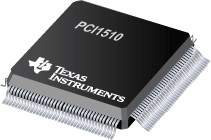

PCI1510是TI公司的一款PCICardBus控制器产品,PCI1510是单槽 PC CardBus 控制器,本页介绍了PCI1510的产品说明、应用、特性等,并给出了与PCI1510相关的TI元器件型号供参考。
PCI1510 - 单槽 PC CardBus 控制器 - PCICardBus控制器 - PCI - TI公司(Texas Instruments,德州仪器)
The Texas Instruments PCI1510 device, a 144-terminal or a 209-terminal single-slot CardBus controller designed to meet the PCI Bus Power Management Interface Specification for PCI to CardBus Bridges, is an ultralow-power high-performance PCI-to-CardBus controller that supports a single PC card socket compliant with the PC Card Standard (rev. 7.2). The controller provides features that make it the best choice for bridging between PCI and PC Cards in both notebook and desktop computers. The PC Card Standard retains the 16-bit PC Card specification defined in the PCI Local Bus Specification and defines the 32-bit PC Card, CardBus, capable of full 32-bit data transfers at 33 MHz. The controller supports both 16-bit and CardBus PC Cards, powered at 5 V or 3.3 V, as required.
The controller is compliant with the PCI Local Bus Specification, and its PCI interface can act as either a PCI master device or a PCI slave device. The PCI bus mastering is initiated during CardBus PC Card bridging transactions. The controller is also compliant with PCI Bus Power Management Interface Specification (rev. 1.1).
All card signals are internally buffered to allow hot insertion and removal without external buffering. The controller is register-compatible with the Intel 82365SL-DF and 82365SL ExCA controllers. The controller internal data path logic allows the host to access 8-, 16-, and 32-bit cards using full 32-bit PCI cycles for maximum performance. Independent buffering and a pipeline architecture provide an unsurpassed performance level with sustained bursting. The controller can also be programmed to accept fast posted writes to improve system-bus utilization.
Multiple system-interrupt signaling options are provided, including parallel PCI, parallel ISA, serialized ISA, and serialized PCI. Furthermore, general-purpose inputs and outputs are provided for the board designer to implement sideband functions. Many other features designed into the PCI1510 controller, such as a socket activity light-emitting diode (LED) outputs, are discussed in detail throughout this document.
An advanced complementary metal-oxide semiconductor (CMOS) process achieves low system power consumption while operating at PCI clock rates up to 33 MHz. Several low-power modes enable the host power management system to further reduce power consumption.
- A 144-terminal low-profile QFP (PGE), 144-terminal MicroStar BGA™ ball-grid array (GGU/ZGU) package, 209-terminal PBGA (GVF/ZVF) package
- 2.5-V core logic and 3.3-V I/O with universal PCI interfaces compatible with 3.3-V and 5-V PCI signaling environments
- Integrated low-dropout voltage regulator (LDO-VR) eliminates the need for an external 2.5-V power supply
- Mix-and-match 5-V/3.3-V 16-bit PC Cards and 3.3-V CardBus Cards
- A single PC Card or CardBus slot with hot insertion and removal
- Parallel interface to TI TPS2211A single-slot PC Card power switch
- Burst transfers to maximize data throughput with CardBus Cards
- Interrupt configurations: parallel PCI, serialized PCI, parallel ISA, and serialized ISA
- Serial EEPROM interface for loading subsystem ID, subsystem vendor ID, and other configuration registers
- Pipelined architecture for greater than 130-Mbps throughput from CardBus-to-PCI and from PCI-to-CardBus
- Up to five general-purpose I/Os
- Programmable output select for CLKRUN\
- Five PCI memory windows and two I/O windows available for the 16-bit interface
- Two I/O windows and two memory windows available to the CardBus socket
- Exchangeable-card-architecture- (ExCA-) compatible registers are mapped in memory and I/O space
- Intel™ 82365SL-DF and 82365SL register compatible
- Ring indicate, SUSPEND\, PCI CLKRUN\, and CardBus CCLKRUN\
- Socket activity LED terminal
- PCI bus lock (LOCK)\
- Internal ring oscillator
Intel is a trademark of Intel Corporation. MicroStar BGA is a trademark of Texas Instruments. Other trademarks are the property of their respective owners.







